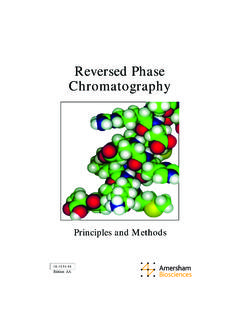Transcription of Selecting Buffer pH in Reversed-Phase HPLC
1 8 Tel: 1-800-255-8324 Fax: 847-948-1078 Specialists in Chromatography Selecting the proper Buffer pH isnecessary to reproducibly separateionizable compounds by reversed-phaseliquid chromatography. Selecting animproper pH for ionizable analytes oftenleads to asymmetric peaks that are broad,tail, split, or shoulder. Sharp, symmetricalpeaks are necessary in quantitativeanalysis in order to achieve low detectionlimits, low relative standard deviations(RSD) between injections, andreproducible retention times. We willdiscuss when buffering is needed, how toselect Buffer pH, and how to choosethe proper Buffer system for that is Buffering Needed?In Reversed-Phase chromatography,mobile phase pH values are usually between2 and Buffers are needed whenthe analyte is ionizable under Reversed-Phase conditions or the sample solution isoutside this pH range. Analytes ionizableunder Reversed-Phase conditions oftenhave amine or acid functional groups withpKa s between 1 and 11.
2 A correctly chosenbuffer pH will insure that the ionizablefunctional group is in a single form,whether ionic or neutral. If the samplesolution is at a pH damaging to thecolumn, the Buffer will quickly bring thepH of the injected solution to a lessharmful to Choose Buffer pHIt is necessary to know the pKa of theanalyte before Buffer pH can be Buffer 2 pH units above or below pKa isrecommended for good peak shape. Fromthe Henderson-Hasselback equation,pH = pKa + log([A-]/[HA])it can be determined that 99% of ananalyte is in a single form if the solution pHis 2 units above or below the analyte s peak shape is possible only when ananalyte is in a single s work through some examples forchoosing mobile phase pH. Suppose weare analyzing benzoic acid, which is shownin its neutral and ionic forms in Figure pKa of benzoic acid is therefore bythe Henderson-Hasselback equation 99%of the benzoic acid molecules will be in theprotonated, neutral form at pH 99%will be in the unprotonated, anion form atpH The protonated, neutral form isrequired for carboxylic acid retention onreversed-phase columns therefore an acidicbuffer at about pH will work.
3 Table 1lists common buffers and their bufferingranges. From Table 1 both phosphate andcitrate buffers are effective at pH Buffer pH to Adjust SelectivityAs mentioned earlier, amine retentiondecreases as the Buffer pH is decreased, acharacteristic that can be used to changeselectivity. If two compounds co-elute andone contains an amine functional group,changing Buffer pH will help to separatethe selectivity for ionizablecompounds is pH dependent, changingbuffer pH can help identify the functionalgroups on unknown analytes. If a peakelutes faster when the pH is made moreacidic, then the analyte probably containsan amine group. If a peak elutes earlier orat the void when the pH is made morebasic, the analyte may be a carboxylic acidsince the ionic form elutes faster than theprotonated neutral properly buffered mobile phase is veryimportant in a successful reversed-phaseHPLC method for optimal peak shape,detection limit, and consistent retentiontimes. Selecting the proper Buffer pH iseasy if you know the analyte s functionalgroups and pKa 1 Common Buffers for Reversed-Phase ChromatographyFigure 1 The neutral and anionic forms ofbenzoic acidIf the analyte contains only aminefunctional groups, Buffer selection is amines will be in the cation form atpH values less than 9, so any buffereffective at pH 7 or lower will work.
4 Youmay ask why use a Buffer at all since water isalready about pH 7. Buffering increases amethod s ruggedness since amine retentionand peak shape are pH dependent. As pHis lowered amine retention times shortenand peak shape sharpens as the bufferprotonates the acidic silanols on the silicasurface. From Table 1 any Buffer with apKa less than 7 is suitable, but we havefound potassium phosphate at pH 3 is thebest for both examples potassium phosphatebuffer at pH 3 works well and in general isan excellent Buffer for analytes that containacid and amine functional groups. We havefound the potassium salt works better thanthe sodium salt for Buffers for Ion-Pair ReagentsA similar process is followed to select abuffer for methods that use ion-pairreagents. Ion-pair reagents such astetrabutylammonium chloride and sodiumheptane sulfonate are ionic mobile phasemodifiers that pair with the ionic functionalgroups of the analyte. A Buffer that putsthe analyte in its ionic form is required inion-pair pKaBuffer RangeREVERSED-PHASE HPLC - - - - - - - - (hydroxymethyl) - - - - Buffer pH in Reversed-Phase HPLC





